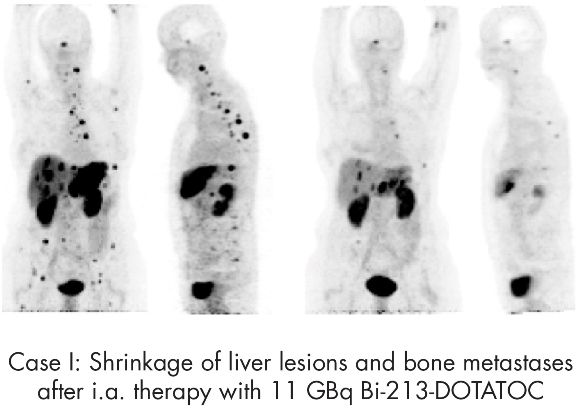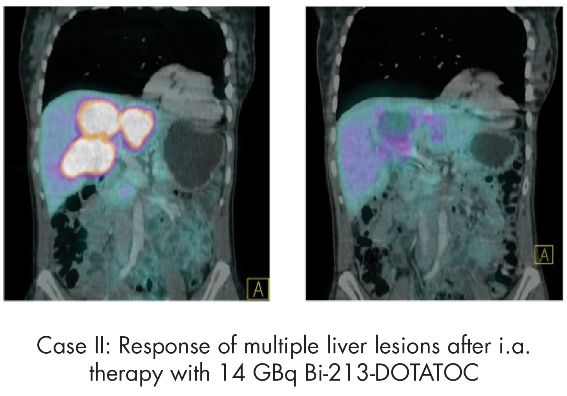SNM Image of the Year: Bi-213-DOTATOC
SNM’s 2012 Image of the Year shows the effectiveness of Bi-213-DOTATOC for the peptide receptor alpha-therapy of GEP-NETs that do not respond to beta therapy.
The Society of Nuclear Medicine’s 2012 Image of the Year shows the effectiveness of Bi-213-DOTATOC for the peptide receptor alpha-therapy of gastroenteropancreatic neuroendocrine tumors (GEP-NETs) that do not respond to beta therapy.
Researchers at the annual meeting this week selected this image from more than 2,000 studies.The annual selection demonstrates the most cutting-edge nuclear medicine or molecular imaging research, SNM said. “The images illustrating the effectiveness of Bi-213-DOTATOC for GEP-NETs show the remarkable results that can be achieved in a clinical setting,” said Peter Herscovitch, MD, chair of SNM’s Scientific Program Committee. “This opens up a new door for those patients whose GEP-NETs do not respond to more standard radiotherapy.”
GEP-NETs are rare, slow-growing tumors that are often resistant to standard chemotherapy. In this study, a Bi-213-DOTATOC was synthesized using a microwave-assisted labeling protocol. Twenty-one patients who had previously shown a resistance to treatment with Y-90 or Lu-177-DOTATOC were treated with escalating doses of the peptide receptor alpha-therapy - from 1-10 GBq up to 21 GBq. Researchers assessed response with Ga-68-DOTATOC PET/CT, contrast-enhanced sonography, MRI, digital subtraction angiography, and tumor markers. In addition, markers for hematologic, kidney and endocrine toxicity were monitored during and after treatment, according to the organization.
The labeling protocol for Bi-213-DOTATOC provided reliable doses of the treatment at a clinical level. Patients tolerated the increasing doses well, and there was no acute kidney, endocrine or hematologic toxicity. Researchers observed shrinkage of primary tumors as well as liver and bone metastases, according to SNM.
Alfred Morgenstern, PhD, project leader of the Alpha-Immunotherapy Project at the European Commission, Joint Research Centre, Institute for Transuranium Elements in Karlsruhe, Germany is the lead author of the study.
Responses to Bi-123 DOTANOC treatment observed in patients with tumors resistant to previous treatment with Y-90 or Lu-177-DOTATOC:


The Reading Room Podcast: Current Perspectives on the Updated Appropriate Use Criteria for Brain PET
March 18th 2025In a new podcast, Satoshi Minoshima, M.D., Ph.D., and James Williams, Ph.D., share their insights on the recently updated appropriate use criteria for amyloid PET and tau PET in patients with mild cognitive impairment.
Expanded FDA Approval Allows Use of Pluvicto Prior to Chemotherapy in Patients with mCRPC
March 28th 2025Recent research demonstrated a 59 percent reduced risk of progression or death with the radioligand therapy Pluvicto in comparison to a change of androgen receptor pathway inhibitor (ARPI) for patients with metastatic castration-resistant prostate cancer (mCRPC).
New AI-Enabled Portable Ultrasound May Facilitate 50 Percent Reduction in Cardiac Imaging Scan Time
March 28th 2025Artificial intelligence (AI)-powered measurement capabilities provide key features with the Compact Ultrasound 5500CV device, which will be unveiled at the American College of Cardiology (ACC) conference.